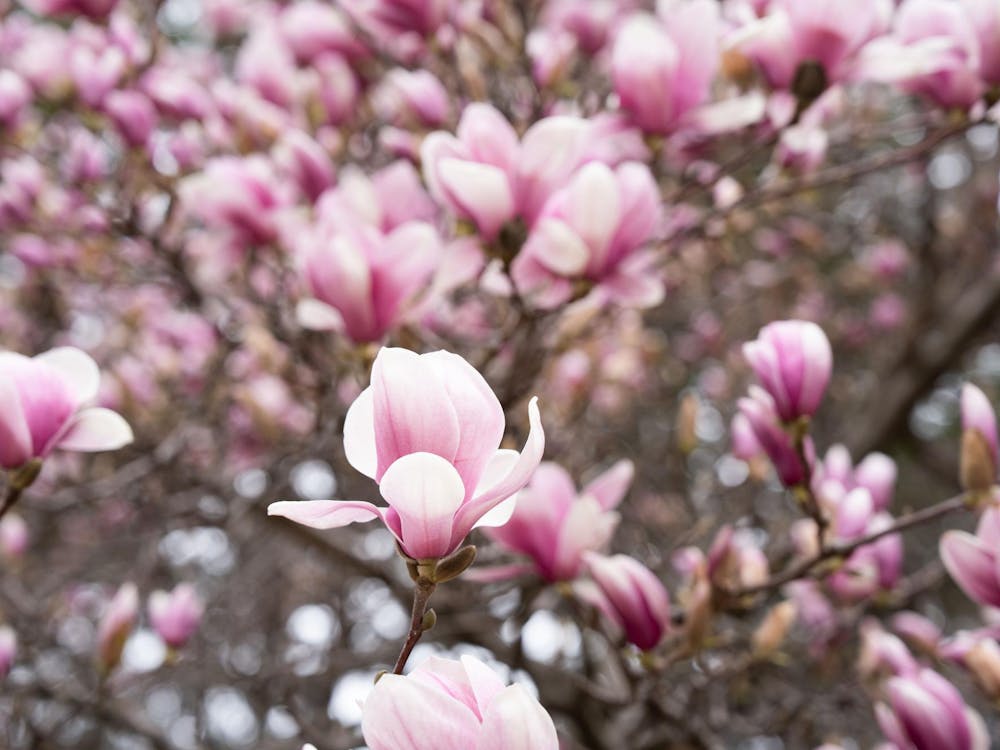The precious minutes before classes wrap for the day are often signaled by the crinkling of paper and the echo of rushed zippers. Cramming loose pencils and expensive laptops into their bags of choice, students brush by each other as they near the classroom exit.
Some students carry bags that are clear forms of aesthetic expression, while others seem to use a bag only because they had to. Wrapping up the last of my classes for the day, I found myself leisurely strolling through the main campus, taking in the clusters of students hauling everything from full backpacks to empty totes. In these moments of observation, here’s what I found.
As groups of students open the heavy wooden doors at McCosh 50, you can’t help but notice a wave of sleek, minimal black bags. Spanning brands from The North Face to Herschel Supply & Co., these bags rarely deviate from the norm with a sleek, minimal aesthetic, except for the occasional decorated pin or sentimental patch.
Many of these bags have been accompanying their student counterparts since their high school years. In an interview with The Daily Princetonian, Nicole Ramirez ’27 said of her bag, “I’ve had her since my sophomore year of high school, and I just have to sew her up every once in a while.”
Aside from the usual worn-down backpack, another familiar backpack among the student body continues the sporty, sleek trend — the Princeton athlete backpack, adorned with tags and symbols of the owner’s sport.
But even athletes are updating their bags — although within the brands under which they are contracted.
“We get one every year. So I’ve just kind of cycled through four backpacks during my time here,” said Mason Armstead ’25, a defensive back on the football team. While athletes aren’t required to wear their issued bags, he mentioned some restrictions on the type of bag he is allowed to carry: “No Under Armour or some other sports teams [brands],” he said, since the Princeton football team contracts with Nike.
Beyond their oftentimes simple exteriors, backpacks are a popular choice of bag because of their useful interiors. With a million random pockets, the most organized (or disorganized) student can neatly manage their items, or at least attempt to. The appeal of these bags is simple, and their function is guaranteed for users: Even the clumsiest student knows that their expensive technology won’t be cracked anytime soon.
Pushing past the sea of black bags and moving towards East Pyne, the bag colors shifted from black to beige and from two shoulder straps to one. Rather than minimalist exteriors and complex interiors, the world of tote bags, designed with the opposite concept, opened in front of me.
Like a treasure hunt without the map, tote users must forage in their bag for their singular pen, which, of course, is right next to the book they don’t read.
Dylan Conard ’27 uses a canvas tote bag that has a light blue painted background stamped with picturesque images of France. Conard found the tote during his trip to Paris, where he was visiting a family member. This was typical with tote users I spoke to: Designs were often tied to the stories of where students found them.
In fact, from the Princeton-branded totes found in the U-Store to totes found abroad in foreign places like Madrid and Greece, it seems that no two totes are the same. Unlike other bags, however, I found that it was rare to see individual expression in the form of attached charms or pins on tote bags. It seems that tote bag users base their individuality on the original design of their tote bag or, simply, whatever was conveniently on the tote, regardless of design.

“I had a backpack, and I switched to a bag just because it’s bigger and more convenient for my computer,” Maria Olivarez ’28 said in an interview with the ‘Prince.’ Olivarez’s current tote is decorated with popular Princeton imagery and was sourced from the U-Store. Doodles of iconic buildings such as the Princeton Chapel are paired with drawings of tigers, making Olivarez’s tote both functional and fashionable.
However, there is one standout tote bag that has recently made waves on campus: the Longchamp Le Pliage Original L Tote bag, specifically in the color Navy. Gaining popularity on social platforms such as TikTok and Instagram, this tote quickly replaced the former slouchy leather tote bag aesthetic that was present last semester.
Some Longchamp owners, like Anamaria Artola ’27, made the switch from using a backpack to a tote. Artola told the Prince, “I like this bag because I only carry my computer and my iPad. Since everything’s on a laptop and it’s pretty light, you can keep it in the tote.”
Combining the possible sore shoulders of the tote bag and the maximum square footage in a backpack, one group of bags balances the expressive traits of tote bags with the organized aesthetic of backpacks: the messenger bag. Ranging in construction from deep red and black leather to lighter canvas fabrics, messenger bags on campus are often decorated with unique and mismatched charms and trinkets.
“I got a carabiner from my host grandmother in Japan, and I also have a little mahjong towel that I got from a gotcha-pong machine,” said Matthew Barrett ’25. Barrett’s bag was gifted from a family member, a trend I saw in other messenger bags around campus. The older aesthetic still serves its purpose for a new generation.
While our bags may serve as our mostly-unacknowledged companions through the experience of Princeton, our choice in how we carry our tools of success might make you give a second thought about bags the next time you rush off to your next class.
Amanda Hugas is a member of the Class of 2027 and a staff writer for The Prospect. She can be reached by her email at ah0942@princeton.edu.
Please send any corrections to corrections[at]dailyprincetonian.com.








